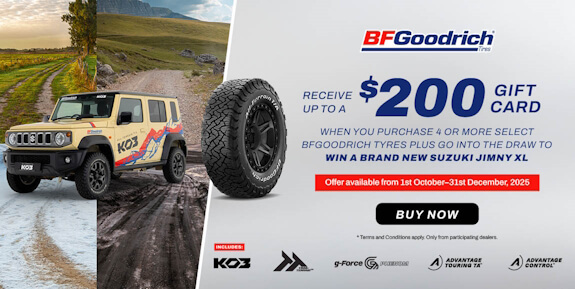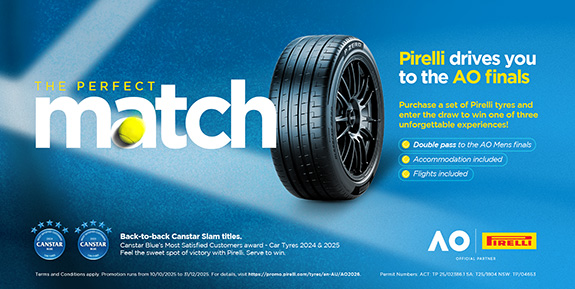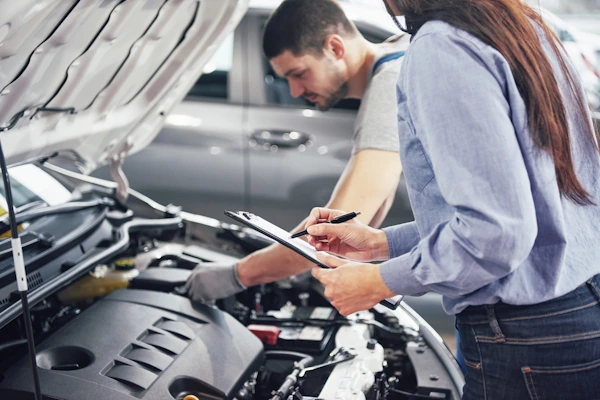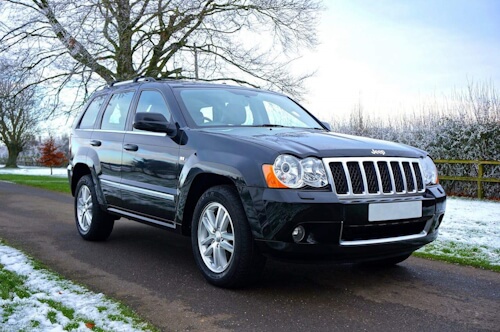Your Guide to Wheel Alignment Service
Proper wheel alignment is vital to getting the most even wear and best performance from your tyres. Properly aligned wheels provide:
-
Safe, predictable vehicle control
-
A smooth and comfortable ride, free of pulling or vibration
-
Improved fuel efficiency
Today’s vehicle suspensions require a precise four-wheel alignment that can only be achieved through a modern wheel alignment service. This applies to both front and rear-wheel drives.
Keep reading to learn everything you need to know about modern wheel alignment services before booking in yours with Tyrepower.
Wheel Alignment Basics
Did you know? A wheel alignment service actually involves adjusting the vehicle’s suspension – not actually the tyres or wheels. That being said, the direction and angles that the tyres point after the wheel alignment is complete are critically important.
There are five key components to a good wheel alignment service: caster, camber, toe, thrust and ride height. These are covered in detail below:
Caster
Caster is the angle of the steering axis (the part of the suspension that supports the wheel and tyre assembly). Viewed from the side of the vehicle, an imaginary line drawn between the centres of the upper and lower ball joints forms an angle with true vertical; this is defined as caster.
The illustration shows whether this angle is referred to as positive or negative. Caster is important to steering feel and high-speed stability.
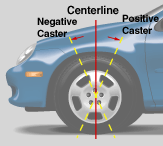
Camber
Viewed from the front of the vehicle, camber describes the inward or outward tilt of the tyre. The illustration shows whether this tilt is referred to as positive or negative.
The camber adjustment maximises the tyre-to-road contact, and takes into account the changes of force when a vehicle is turning. Camber is the one adjustment that can be set according to driving habits.
Generally, if you drive more aggressively when concerning, a more negative camber can be set. If you drive on highways and do very little hard cornering, more positive camber can be set.
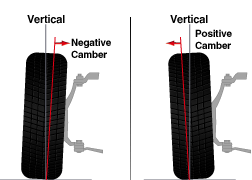
Toe
Toe describes whether the fronts of the tyres are closer (toe-in) or farther apart (toe-out) than the rears of the tyres. The illustration shows this relationship, viewed from above.
To settings vary between front and rear wheel drive vehicles. In a front wheel drive, the front wheels try to pull toward each other when the vehicle is in motion, which requires a compensating toe-out setting. A rear-wheel drive vehicle works just the opposite, necessitating a toe-in setting.
Stated differently, toe is set to let the tyres roll in parallel (at zero toe) when the vehicle is in motion.

Ride height
Put simply, ride height is the distance between the vehicle’s frame and the road. This is the reference point for all alignment measures. Vehicle customising very often will include raising or lowering the vehicle. If you do this, don’t forget to have a wheel alignment service afterwards. This also applies if you put a taller or shorter tyre on your vehicle.
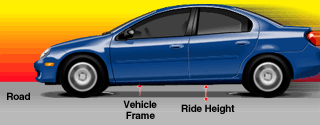
Misalignment and Tyre Wear
By now you may have concluded that poor tyre wear and misalignment are closely related. That of course is true, but what can be done to minimise this condition?
Many of the above wheel alignment conditions can be easily determined, if you know what to look out for. To help with this, take a look at the following chart:
| Misalignment Condition | Tyre Wear Symptom |
|---|---|
| Incorrect camber setting | Premature smooth wear on either inside or outside shoulder |
| Incorrect toe setting | Feathered wear across tread; raised tread block edges |
| Incorrect caster setting | Excessive shoulder wear; tread blocks show “heel-toe” wear pattern |
| Unequal caster setting (either right or left side is out of specification) | Sharp pulling necessitates steering compensation and feather wear |
| Unequal toe setting | Sharp pulling necessitates steering compensation and feathered wear |
| Combination of two or more settings are out of specification | Irregular tread wear, with feathering and smooth spots |
This chart is not exhaustive, but if you learn to spot these symptoms early, you can get a lot more tread wear from your tyres. Alternatively, you can always pop into your local Tyrepower and speak to a professional who will be able to diagnose your tyres.
Worn parts
It’s important to note that tyres take the brunt of a range of problems. Replacing the old ones is not always the solution. For example, in a lot of cases a worn suspension is the cause of a wheel alignment problem. If you simply replaced the tyres, you’d quickly find your new tyres begin to reflect the same problems you had before.
There are many other parts that can wear out and cause wheel alignment issues. On older vehicles, worn springs can lower a vehicle’s ride height, altering its geometry and creating a misalignment (as mentioned above, all alignment settings are dependent on ride height). Weak springs can also contribute to uneven or “cupped” tyre wear.
Another common problem is worn ball joints. The symptoms here are erratic handling, slow steering response and irregular tyre wear. Finally, worn tie roads can allow the tyre to wander left to right, effectively changing toe as the vehicle rolls down the road. Irregular feathering will develop on the tyre tread when this is the problem.
Tyre imbalance
If your tyres haven’t been fitted properly, this can cause imbalances and lead to your wheels becoming misaligned. That’s why it’s always recommended you get a professional to complete your tyre fittings.
Again, this isn’t an exhaustive list, but if you stay alert to these common problems, it may help you schedule an early visit to your mechanic and save on tyre wear.
“Alignment is crucial to getting the most out of your tyres.”
A fundamental component to proper tyre care is your wheel alignment. To ensure you’re getting the most out of your tyres, make sure you arrange a regular wheel alignment service from a trusted specialist. Tyrepower can help you with all your tyre maintenance needs.
If you’re ready to book yours, call Tyrepower on 13 21 91.
Please call on to enquire today, or visit their at to book an appointment.
Not your store? Find your nearest Tyrepower here.



















